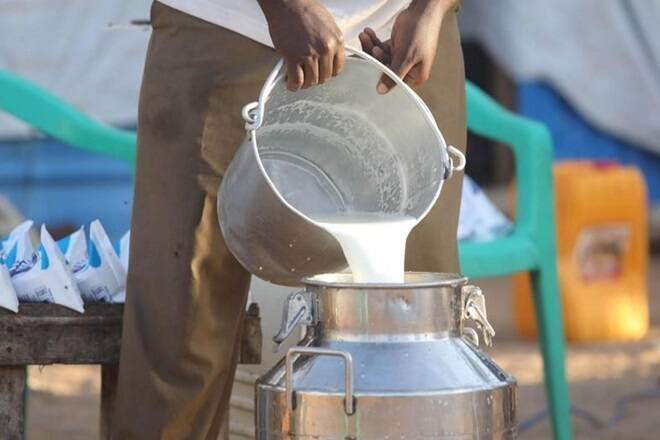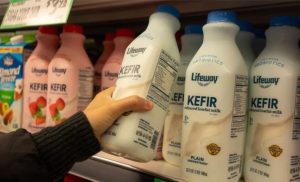For Jagtar Singh of Katlaheri village of Kurukshetra district, Haryana, dairying has been a livelihood for generations. Increasing cost of feeding and poor fertility of his animals used to bother him. The Karnal Milk Union introduced the Ration-Balancing Programme (RBP). RBP ensured that the farmers like Jagtar were introduced to Local Resource Persons (LRPs) like Baljinder Singh, who formulated a balanced ration for milch cows of Holstein Friesian (HF) breed. In a month’s time, the milk yield of the cows increased by 800 gm daily per animal, while milk fat improved from 3.2% to 4.0% and Solid-not-Fat (SNF) from 7.8% to 8.1%. With the adoption of the RBP, the average ration cost has declined by Rs 41 per animal per day.
Mori Ruda Rina is a cotton farmer from Mokhan village of Jamnagar district of Gujarat, who also owns dairy animals. Despite feeding the animals with high-nutrient cotton seeds, the milk yield was low. As the animals were fed more than the required quantity of feed, they gained weight and did not come into their regular heat. After a meeting conducted by Maahi Milk Producer Company, Rina registered himself for RBP advisory services. The LRP recommended a formulation for balanced ration for animals that included mineral mixture. Four months after the adoption of the RBP, Mori’s feed cost was reduced by up to Rs 24 per animal per day and increase in milk production to the tune of 1 kg per animal per day.
The RBP was designed to be a large-scale demonstration of the benefits of balanced feeding to dairy animals. The RBP was the critical component of the World Bank-supported National Dairy Plan (NDP) Phase I (during 2011-12 to 2018-19) in 18 major milk-producing states. One of the key focus of the NDP-I was to increase the productivity of milch animals and thereby increase milk production to meet the rapidly-growing demand for milk. Under the NDP, 28.66 lakh farmers were educated about the nutritional needs of cows and buffaloes, and balanced ration advisories were offered to them through 31,148 LRPs, covering 33,374 villages in these 18 states.
Prior to the implementation of the NDP- I, most of the feed-related interventions in India were limited to the supply of compound cattle feed and mineral mixture only. This led to lower productivity of animals as against their genetic potential, higher cost of production, late onset of puberty, etc. Farmers also used to feed their animals based on traditional knowledge and information passed through generations. They fed their animals with the crop-residues, locally available concentrate, ingredients such as bran, oil-cakes, grains, etc, and seasonally-available green fodders. Often, farmers either did not give mineral mixture or gave small quantities to animals. In most of the cases, the quantity of feed or fodder given to animals was either more or less than the requirements. This resulted in an imbalance of protein, energy and minerals in their ration, which adversely affects the health and productivity of animals. This had a direct impact on the farmers’ income.
The National Dairy Development Board (NDDB) developed a software-Information Network for Animal Productivity and Health (INAPH)-through which ration of dairy animals could be balanced. Taking into consideration regional variations, nutrient masters were created for different categories of dairy animals, and district-wise feed libraries were developed.
The key aspect of the implementation of the RBP was the identification of the LRPs, who were trained on animal nutrition and handling of software. The LRPs had weighing balance, measuring jar, ear-tag applicator, booklets and netbooks preloaded with RBP software. The LRPs used to visit the farmers household, tag the selected animal’s ears, measure the girth of the animals for bodyweight estimation, weigh feed ingredients offered by the farmers, measure milk yield and fat content, etc. Based on these information being fed into the RBP software, the balanced ration for the animals used to be recommended. The LRP revisited the farmer monthly to record the changes in milk yield, fat content, etc, and reformulate balanced ration.
After seven years (2011-12 to 2018-19) of implementation of the RBP, on an average, there was an increase of `25.5 in net daily income of the farmers per animal due to reduction in feed-cost and additional milk yield and increased fat content. The RBP also resulted in an average increased lactation period (milk days) of 26 days for cows and 50 days for buffaloes. Further, feeding balanced rations to dairy cows and buffaloes resulted in average 13.7% reduction in enteric methane emission per kg of milk.
After completion of NDP I, the RBP is being implemented by nine states at present. The RBP was successful in reaching out to 2.1 million farmers. To reach more farmers, the NDDB has developed the Pashu Seva App that can be used to optimise feeding costs and manage common diseases. The app also notifies farmers about due dates for de-worming and booster vaccination, artificial insemination and pregnancy check. The Pashu Seva app is freely downloadable for dairy farmers, and would soon be available in Hindi as well as many regional languages.
These initiatives can ensure sustainable growth of the dairy sector as well as boost incomes of millions of small and marginal dairy farmers.
The author is Chairman, National Dairy Development Board













